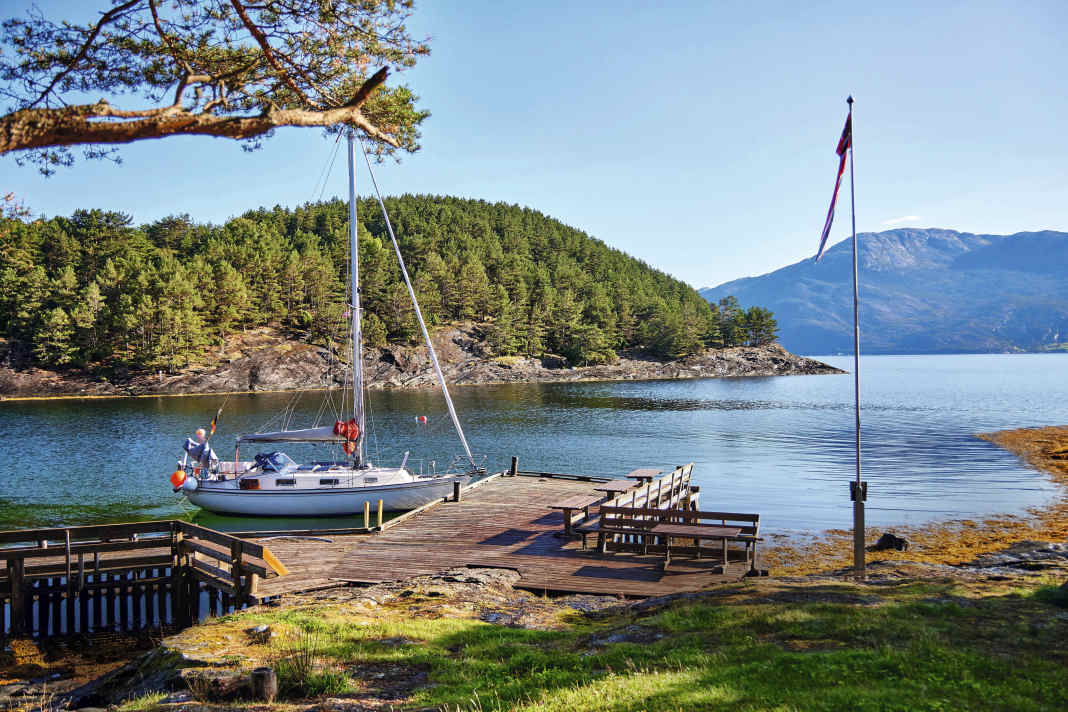





This is clearly a dead end, albeit one of the most beautiful you can imagine: The grey rock lies steep and high ahead and on the port side a wall of granite and gneiss rises up to the sky. Only to starboard do the smoothly polished rocks open up into a river valley, at the mouth of which there is a green meadow, a few leafy trees and a few houses with slate roofs and thick wooden planks, brightly lit by the white paint. It is the village of Eidfjord, built centuries ago on the fjord of the same name.
The concrete pier to which I tie my boat is tiny; everything here seems small and insignificant in the shadow of the monumental mountains in the easternmost corner of Norway's Hardangerfjord. What am I doing out here in the middle of nowhere? I'm picking up a sailing friend from the bus.
There are exciting views of mountains, glaciers and waterfalls everywhere. The area surprises and never gets boring
The national road no. 7 winds for kilometres along the fjord at the foot of the steep slopes, and the red and white bus in which my new pax is sitting can be seen from afar as it curves towards Eidfjord. Minutes later, he is actually standing on the pier, with small luggage and a large gift of high liquidity for the skipper, which we immediately use to toast together: "Skål Timo og velkommen til Hardangerfjord!"
A fjord cruise to recover from the Skagerrak
Timo Lantzsch is my co-sailor for a week on the world's third longest fjord and has travelled here from Risør in southern Norway. The master boat builder from Fehmarn and with a small shipyard in Kappeln on the Schlei likes to go on long trips with his wooden folk boat in the summer, and he has sailed from Schleimünde to the wooden boat festival in Risør once again. With a boat just under eight metres long and without a self-draining cockpit, this is not a coffee cruise, which is why he received the 2023 Long Cruise Award from the Friends of Classic Yachts.
Now he wants to spend a week recovering from the rigours of the Skagerrak and explore fjords, mountains and waterfalls with me: from Eidfjord to the west coast to Haugesund. At around 100 nautical miles in a week, the trip seems somewhat undersized for cruising sailors of our calibre, were it not for the numerous natural beauties on both sides of the course.
Many possibilities in a small space
"How much activity can we take?" I ask Timo the next morning over coffee in the cockpit, who can only shrug his shoulders in response. Understandable, where should we start with so many options? Just a few kilometres from the mooring in Eidfjord, the waterfall Vøringsfossen plunges 182 metres into the depths, around the corner in Sørfjorden the spectacular rock plateau of Trolltunga towers over the valley at a lofty height, and on the other side of the fjord the ice and snow-covered Folgefonna glacier shows its white hump. Further west in Ytre Samlafjorden, the geographical centre of the Hardangerfjord, the natural wonders continue with the bay of Norheimsund, home to a museum shipyard and another famous waterfall, the Steinsdalfossen.
We feel like little children standing in a gigantic theme park for the first time and can't decide between a rollercoaster, a giant slide and candy floss.
We feel like small children standing in a gigantic theme park for the first time and can't decide between a rollercoaster, a giant slide and candy floss. We choose the geographically most obvious option first, walk the 300 metres through the village and end up at the "Kafé og Kremmeri", fill our stomachs with delicious homemade cakes and enjoy an espresso prepared by a barista. This place is also one of the wonders of the Hardangerfjord, because who would expect an exquisite patisserie in the barren Nordic fjell landscape at the end of an inlet?
Sailing in the fjord is possible, but the wind is difficult to predict
"Cast off and out onto the fjord," shouts Timo, the decision to make a flying visit to the Sørfjords has been made. And we're off before the large cruise ships block the view of the landscape and unload their cargo of thousands of selfies in the small town.
From the centre of the fjord, the rock faces and boulders look even more gigantic, and the white clouds from the sky are now reflected in the dark water. The cloths are now all up, but down here in the glacier-carved water furrow there is hardly a breeze. The weather forecast had promised us much more.
"Sailing in the fjord is definitely possible. The general weather situation provides certain conditions, but the wind direction is difficult to predict and the meteorological models are usually wrong when it comes to wind strength," Ragnar from the harbour crew in Norheimsund will later explain to us in his best English. "The local geomorphic characteristics are too varied to define the weather situation of a micro-region."
Aha, sounds kind of logical, but to be on the safe side I ask: "So it comes as it comes?" Ragnar confirms with a brief nod. He studied meteorology and oceanography in Oslo for a few semesters, but then got stuck here on a holiday job. The illusion of a predictable Norwegian wind generator has now been dispelled.
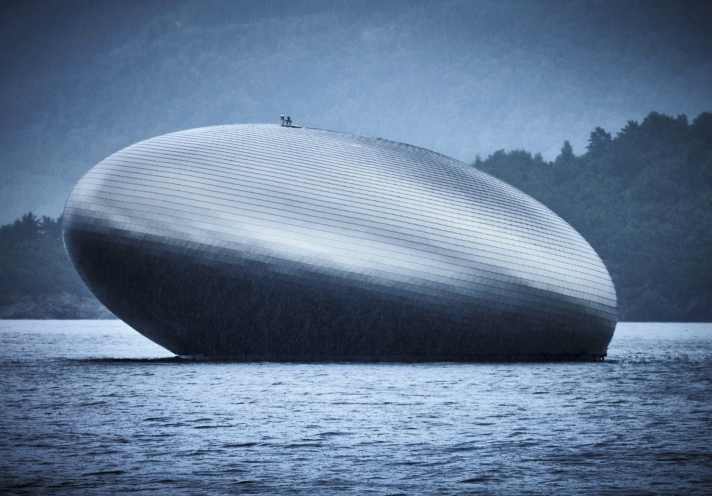
The Hardangerfjord offers the best of both worlds
After we have not moved an inch for some time, the engine is started and the beat of the hammering pistons echoes off the rock faces. "If there are elves here, are they all awake or deaf now?" comments Timo on the diesel concert as we are gently pushed into the Sørfjorden. We can hardly believe our eyes, we can see huge fruit plantations along the sides of the fjord! A sight that doesn't attract much attention at Lake Constance, but here in the far north and just a few kilometres from the icy glacier of the Jostedalsbreen, it causes great astonishment - at least for us. "We have the best of both worlds," explains Olav Bleie. "A mild winter thanks to the eastern inland climate, and the rain showers from the west are stopped by the mountains."
Bleie is an apple grower near Lofthus and his family has been running an apple farm since 1864. The fruit is then used to make the world's most exclusive sparkling apple wine and apple juice. The cider is like the champagne of the fjords. "We have a microclimate that the apples love," says the fruit grower happily. But in addition to the apples, it is also the tourists from home and around the world who are enthusiastic about the moderate temperatures in this region.
Off to the museum shipyard in Norheimsund
Our stopover in Lofthus on the Sørfjorden will be washed down with a cider tasting, and the next day we will cruise westwards on the Indre Samlafjorden, which offers enough space for longer trips. Now we want to go to Norheimsund, a town known for its large museum shipyard with workshops for traditional boatbuilding crafts and festivals with classic yachts.
The large bay in front of the town is well protected by an offshore island and offers good anchorage, and the yachts are also safe in all wind directions at the moorings in the comfortable marina. White wooden houses, green lawns and red roses are a nice change in the otherwise granite-grey landscape. A few kilometres inland, the Steinsdalfossen plunges down the fell. The highlight here is the path between the rocks and the masses of water, which give us a spectacular view behind the water column.
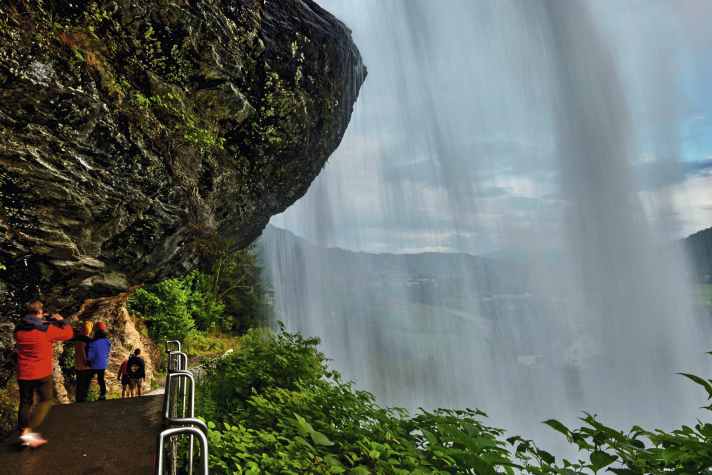
See Norway's glaciers while you still can
We've already seen a lot in just a few miles in Fjord Norway, but one thing is clearly still missing from our wish list: "A glacier!" Timo has been impatiently urging us since his arrival that he wants to get up into the fjell, close to a glacier, before man-made global warming melts the last of the ancient ice from the mountains. The mighty ice caps of the Folgefonna glacier have been in view for days on our fjord cruise, visible from afar, nestled on the platform of the Folgefonna peninsula. Many roads lead from the Hardangerfjord to the Norwegian mainland ice. We set course for the Maurangerfjord and moor in Sundal, a small village with a campsite, quay and jetty. The season up here is short, which justifies the simple maritime facilities. And what do cruising sailors need in Norway apart from drinking water, electricity and the occasional hot shower? We came for the magnificent experience of nature and not to stare into the neighbouring cockpit in fancy marinas.
We came for the magnificent experience of nature and not to stare into the neighbouring cockpit in fancy marinas.
"That way," Timo calls out, pointing up the Bondhusdalen valley, with the Folgefonna glacier tongue visible directly behind the top of our mast. We get ready for the tour, put on our hiking boots and shoulder our rucksacks. Then we finally make our way up the old "ice path" from 1863, along which the chunks of ice were brought down from the glacier to the fjord by horse and carriage and exported abroad. Where the Folgefonna ice once ended is now the large ice-cold mountain lake Bondhusvatnet. Clambering up to here is still child's play without cramping calves and aching muscles. But if you want to hike further up and over the glacier, you should join a rope team and walk the historic hiking route from Sundal to Odda, over Norway's third largest mainland glacier, together with mountain guides.
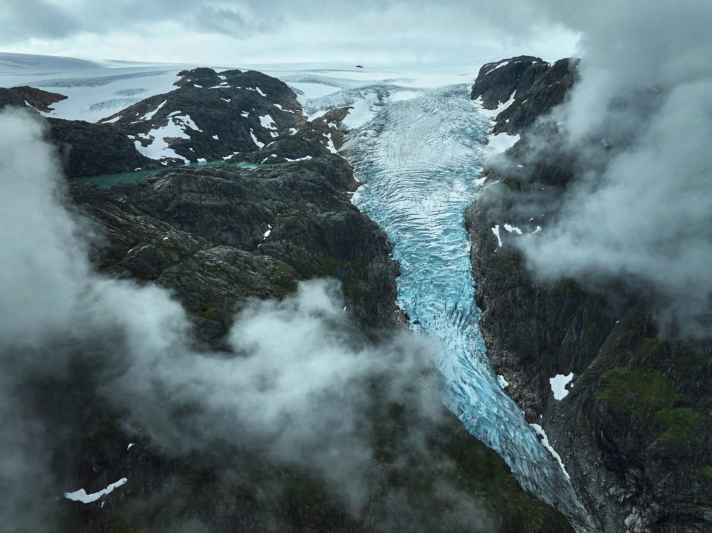
Sailing in the Hardangerfjord - unreasonableness or jackpot?
We turn round here and walk back down to the boat. "We're a hell of a long way from our home port, have a lot of bad weather and often headwinds or none at all, pay ten euros for a beer and are moored in small harbours with a lot of swell. Is this trip pure unreasonableness or the main prize for an unforgettable journey?" I summarise. Timo looks down at the grey-blue fjord and over the ice-age shaped smooth rocks and answers: "It's the jackpot."
The region and the village of Rosendal, around 15 nautical miles to the south-west, have been shaped less by the forces of the Ice Age than by the human muse and creative urge. The rock faces of the fell, which hold the Folgefonna glacier as if in an embrace, fall away steeply here and open up a wide open landscape, in which the fjord now also reveals a different shape and welcomes water sports enthusiasts with small islands, bays and good anchorages.
Nowhere could be more beautiful
The tranquil village is home to Scandinavia's smallest castle - the Barony of Rosendal dating back to 1665 with a magnificent Renaissance garden, famous for its many roses. And after cold days on the fjord, the human soul can warm up again here, as Rosendal offers a remarkable cultural programme in summer with concerts, castle courtyard theatre and art exhibitions.
A week's sailing in the Hardangerfjord is now in our wake. We are sailing westwards and the waves are getting noticeably longer. The wind is brimming with power and the spray on our lips is as savoury as brine: we can now feel and taste the Atlantic. Not far from the entrance to the Hardangerfjord lies the old trading and shipyard town of Haugesund with its magnificent white wooden houses and rich history of Vikings, kings and empire founders. But that's another story, because this journey ends at some point, as every encounter does: with a farewell. Timo gets on the bus to Risør and heads back to his folk boat. My boat and I will stay on the Norwegian west coast for a few more miles. Close to the fjords, because nowhere could be more beautiful right now.
Area information Hardangerfjord
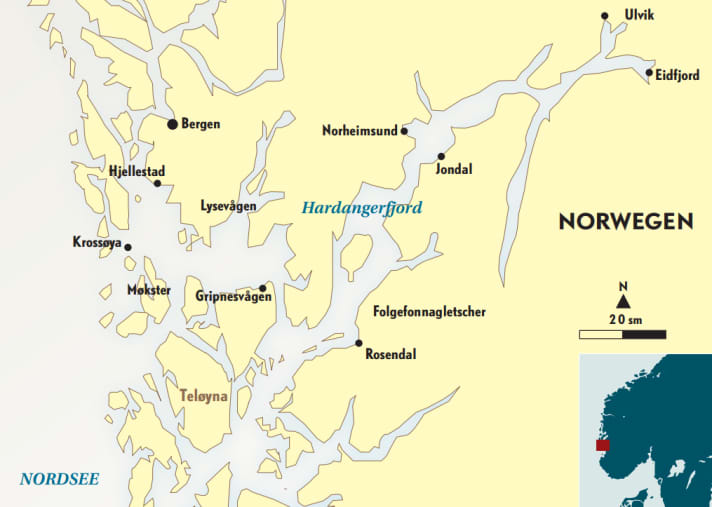
Journey
With your own yacht from Kiel-Kristiansand-Stavanger-Rosendal approx. 260 nautical miles. Bareboat charter is a rarity in Norway and expensive. Scansail, for example, organises a small selection of yachts from Stavanger or Bergen; mostly with skipper, from approx. 4,000 euros/week. SCANSAIL.COM/EN
Climate and weather
Thanks to the Gulf Stream, Norway has a warmer climate than other places at the same latitude, such as Alaska or Siberia. This does not mean tropical heat: the average temperature from June to August is 16 degrees Celsius, and of course there are also sunny days with temperatures of around 25 degrees Celsius. Even in summer, the weather can change quickly and bring wind and rain, the latter statistically occurring on six days during the summer months. The water temperature in summer is between 13 and 18 degrees Celsius. The wind is usually moderate to fresh, with lulls in the inner fjords.
Navigation + Seamanship
Marinas, jetties and harbours are often floating jetties, which are only deployed in the summer months, and municipal quays or ferry berths. You should be prepared for anything: Mooring at stern buoys, in boxes, alongside jetties or rustic piers. Anchoring is possible in a few places in the fjord, preferably in the estuaries of rivers or between islands and in bays. Fast ferries and pleasure craft cause swell that can build up in the narrow fairways. Caution is advised when mooring on rocks and at anchor; downdraughts and jet effects are also possible. The equipment includes a stern anchor, fender board, large ball fenders, extra-long lines for mooring to rock hooks and wedges. The fairways are clearly buoyed and shallows are marked, otherwise the water depths are sufficient. The waves can build up uncomfortably in strong winds, especially in narrow passages, the tidal current is negligible, the swell is around 0.5 metres. Mobile phone coverage is good in almost the entire area.
Nautical charts, manuals + apps
- Navionics plotter charts ("Norway, Lakes and Rivers") or as an app;
- Official nautical charts: "Norway N 118 Fjord world inner Hardangerfjord" and "N 117 outer fjord", Kartverket Norge;
- Precinct manuals: "Havneguiden 3 - Lindesnes to Bergen", Skagerrak-Verlag; Norway (RCC)/Judy Lomax, "The Cruising Almanac 2024", Imray

